Get upskilled in just 3 hours with our new short online primers. You'll benefit from videos, illustrated course books, dedicated tutor support, and regular assessments, and earn digital badges to showcase your achievement. All included in the Wray Castle Hub subscription.
Short On-Demand Industry Primers
-

Introduction to MEC (On-Demand)
Multi-access Edge Computing (MEC) is redefining how services are delivered by bringingcomputing power closer to the user - at the network edge. This approach reduces latency,improves efficiency, and enables new applications across industries. In this course, you’ll start by answering the question: What is MEC? You’ll explore itsconceptual foundations, the role of ETSI, and the drivers behind this shift, including costrealignment and the need for ultra-low latency. The course introduces enablingtechnologies such as cloud computing, virtualization, NFV/SDN, and 4G/5G, showing howthey combine to make MEC possible. Next, you’ll examine the MEC architecture, including service-based interfaces and highlevelrequirements for features and services. You’ll dive into real-world use cases, fromvideo analytics and location-based services to Industry 4.0, AR/VR, and V2X applications.The course also addresses challenges posed by MEC and how they are being overcome.Designed for professionals in telecoms, IT, and emerging technology fields, this courseprovides a clear, practical introduction to MEC - ideal for anyone seeking to understandhow edge computing enables next-generation services. Course Contents Introduction to MEC What is MEC Enabling Technologies for MEC MEC Overview MEC Architecture Requirements Use Cases Emerging Technologies
£95.00
-

Cellular Communication - Idle and Connected Mode Activities (On-Demand)
Mobile devices constantly switch between idle and connected states to balanceperformance and power efficiency. Understanding these activities is essential for anyoneworking in mobile networks, radio planning, or device optimization. In this course, you’ll start with idle mode activities, exploring how devices select andreselect cells across technologies like GSM, UMTS, LTE, 5G, and Wi-Fi. You’ll learn aboutpower-on procedures, cell selection criteria, location updating, and how routing and trackingareas are managed. The course explains key parameters such as C1 and C2, andintroduces advanced concepts like URA updates and PLMN selection. Next, you’ll dive into connected mode activities, covering measurement procedures andhandover strategies for GSM, UMTS, LTE, and 5G. You’ll explore how devices report signalquality, trigger events for handover, and maintain connectivity during mobility. Topicsinclude soft handover, outer loop power control, and advanced measurement events (A1–A6, B1–B2) used in 5G networks. You’ll also learn about automatic neighbour relations andhow they simplify network management. Designed for professionals in telecoms and wireless engineering, this course provides aclear, practical introduction to idle and connected mode operations - ideal for anyoneseeking to understand how mobile devices interact with cellular networks in real-worldscenarios. Course Contents Idle Mode Activity for Mobile Devices GSM Cell Selection GSM Cell Reselection Location Updating UMTS Cell Selection and Reselection UMTS Update Procedures LTE Power On Procedure LTE Cell Reselection 5G Cell Selection Procedure 5G Cell Reselection Wi-Fi Mobility Connected Mode Activity for Mobile Devices GSM Handovers UMTS Handovers LTE Handovers 5G Handovers
£95.00
-

Radio Surveys: Practical Tool Use - an Introduction (On-Demand)
Accurate radio surveys are essential for planning, optimizing, and troubleshooting wirelessnetworks. This course introduces the tools and techniques used in real-world surveyscenarios, helping you understand how measurements are captured and analysed forreliable coverage. In this course, you’ll start with practical demonstrations of survey tools, including drivesurvey systems, R&S ROMES drive test software, and R&S TSMA radio scanners. You’lllearn how measurements are recorded outdoors and indoors, and explore advancedfeatures such as automatic cell detection (ACD), cellular coverage surveys, and basestation analysis. The course also covers cell position estimation, handover analysis, andWi-Fi coverage surveys, giving you a comprehensive view of survey applications. Next, you’ll gain guidance for conducting radio network surveys, including best practices forpersonal safety, spot/location surveys, route profiling, and indoor coverage assessments.You’ll learn how to choose between idle mode and connected mode measurements, andhow to perform specialized surveys such as network profiling and aeronautical surveys.Designed for professionals in telecoms and wireless engineering, this course provides apractical, hands-on introduction to radio survey tools and techniques - ideal for anyoneseeking to understand how coverage data is collected and used to optimize networkperformance. Course Contents Tools for Radio Surveys - Practical Demonstrations Mobile Drive Survey Tools PC Based Survey Tools Indoor Surveys Radio Scanners R&S NESTOR Survey Tool Automatic Cell Detection (ACD) Cellular Coverage Surveys Base Station Analysis Cell Position Estimation Wi-Fi Network Surveys Guidance for Radio Network Surveys Guidance for Radio Network Surveys
£95.00
-

Radio Propagation, Interference and Coverage - an Introduction (On-Demand)
Radio signals don’t just travel in straight lines - they interact with the environment incomplex ways. Understanding how propagation works, and what affects coverage andinterference, is essential for anyone involved in wireless communications, broadcasting, ornetwork planning. In this single-module course, you’ll start with the fundamentals of radio propagation,exploring how signals behave across different frequency bands - from VLF and LF throughHF, VHF, and beyond. You’ll learn about the role of the ionosphere, how conditions varybetween day and night, and how space waves enable long-distance communication.Next, you’ll examine radio coverage, including key factors such as reflection, scattering,diffraction, and attenuation. The course explains how terrain, clutter, and atmosphericanomalies impact signal reach, and why coverage planning is critical for reliable service. Finally, you’ll dive into radio interference, covering issues like co-channel and adjacentchannel interference, illegal operation, and frequency planning. You’ll also explore howweather conditions and noise affect performance, and what strategies help mitigate thesechallenges. Designed for professionals in telecoms, broadcasting, and wireless technologies, thiscourse provides a clear, practical introduction to radio propagation, coverage, andinterference - ideal for anyone seeking to understand the principles behind reliable radiocommunication. Course Contents Propagation Radio Coverage Radio Interference
£95.00
-

NFV Architecture and Infrastructure (On-Demand)
Network Functions Virtualisation (NFV) is transforming how modern networks are built, managed, and scaled. By decoupling network functions from proprietary hardware and running them on virtualised environments, NFV enables flexibility, efficiency, and innovation across telecom and IT ecosystems. In this course, you’ll explore the NFV functional architecture and the NFV Infrastructure (NFVI) that underpins it. Starting with the NFV framework and its core principles, you’ll learn how virtualised network functions (VNFs) are composed, scaled, and interconnected. The course introduces key concepts such as VNF descriptors, forwarding graphs, and reference points, giving you a clear view of how NFV systems communicate and operate. You’ll also dive into the NFVI layer, examining its components - compute, storage, and networking, and how technologies like hypervisors, cloud computing, and virtualisation enable NFV deployments. Topics include performance optimisation, security aspects, and advanced techniques such as CPU pinning, micro-segmentation, and VXLAN overlays. By the end, you’ll understand how NFV and MANO (Management and Orchestration) work together to deliver agile, scalable network services. Designed for professionals in telecoms, IT, and network engineering, this course provides a practical, jargon-free introduction to NFV architecture and infrastructure - ideal for anyone looking to understand the foundations of virtualised networking without diving into vendor-specific details. Course Contents NFV Functional Architecture NFV Framework and VNFs Virtual Links and Forwarding Graphs Reference Points and Infrastructure Options NFV Infrastructure (NFVI) NFVI Architecture NFVI and Virtualization Hypervisor Domain Containerisation Compute and Infrastructure Network Domains NFVI Implementation
£95.00
-

Cellular Radio Measurements (On-Demand)
Cellular networks rely on precise measurements to deliver reliable coverage and highqualityservice. Understanding these principles is essential for anyone working in mobilecommunications, network planning, or performance optimization. In this course, you’ll start with the foundations of cellular radio, exploring traditionalcoverage methods, the cellular philosophy, and concepts like reuse distance, cellhierarchies, and antenna configurations. You’ll learn how propagation, multipath effects,and fading - such as Rayleigh and Rician fading, impact signal quality, and how diversitytechniques improve performance. Next, you’ll dive into radio measurements, covering key concepts such as logarithms,decibels, and power levels in dBm and dBW. The course explains how to perform systemcalculations and interpret measurements across technologies including GSM, UMTS, LTE,and Wi-Fi. You’ll explore metrics like RSRP, RSRQ, SINR, and timing advance, and seehow best-server plots are used for network optimization. Designed for professionals in telecoms and wireless engineering, this course provides aclear, practical introduction to cellular radio measurements - ideal for anyone seeking tounderstand how signal strength and quality are assessed in modern mobile networks. Course Contents Cellular Radio Principles Cellular Philosophy Base Stations Cellular Coverage Cells in Built up Areas Propagation Issues Radio Measurements Decibels GSM Measurements UMTS Measurements LTE Measurements SINR Measurements 5G Measurements Wi-Fi Measurements
£95.00
-

Cellular Backhaul Technologies (On-Demand)
Backhaul is the backbone of mobile networks, connecting cell sites to the core and ensuring seamless service delivery. As networks evolve to support 4G, 5G, and beyond, understanding backhaul technologies and planning principles is critical for telecom professionals. In this course, you’ll start with an overview of backhaul planning, including traditional and evolved requirements, architecture for multi-RAT environments, and techniques for dimensioning transport networks. You’ll learn how backhaul supports access networks and why its design impacts performance and scalability. Next, you’ll explore transport network architecture, covering 3GPP definitions, layered design, and evolution toward multi-operator and multi-RAT solutions. The course examines backhaul transmission options, comparing Layer 1 technologies, Ethernet physical layers, and microwave radio systems, along with their capacities and limitations. You’ll also dive into synchronization for mobile backhaul, including frequency, phase, and time requirements. Topics include Precision Time Protocol (PTP), Synchronous Ethernet, telecom profiles, and synchronization architectures for packet-based networks. Finally, you’ll review industry initiatives and standards, such as NGMN and MEF, and learn how IP/MPLS, VLAN management, and QoS mapping enable secure, resilient backhaul. The course addresses security, load balancing, and operational best practices for modern mobile networks. Designed for professionals in telecoms and network engineering, this course provides a clear, practical introduction to cellular backhaul technologies - ideal for anyone seeking to understand how transport networks evolve to meet the demands of next-generation mobile services. Course Contents Backhaul Planning Overview Transport Network Backhaul Technologies Synchronisation of Mobile Backhaul Backhaul Initiatives
£95.00
-

MEC APIs and Service Integration (On-Demand)
Multi-access Edge Computing (MEC) relies on robust APIs and standards to enableseamless integration of applications and services at the network edge. Understanding these interfaces is key to unlocking MEC’s full potential in 5G and beyond. In this course, you’ll start with an overview of MEC standards and the ETSI standardizationprogramme, including the latest developments and principles behind API design. You’llexplore core APIs such as Radio Network Information, Location Services, UE Identity,Bandwidth Management, and Multi-Traffic Steering, as well as APIs for WLAN, fixedaccess, V2X, and IoT. The course also covers application management interfaces,including lifecycle management, package management, and application descriptors (AppD). Next, you’ll dive into advanced topics such as MEC federation, support for slicing, securityand regulatory considerations, and best practices for QoS measurement. You’ll learn howMEC integrates with 5G networks, including traffic steering, local access to the 5G datanetwork, and mapping MEC APIs to CAPIF. Real-world examples, proofs of concept, anddeployment trials illustrate how MEC APIs enable interoperability and innovation acrossdiverse ecosystems. Designed for professionals in telecoms, IT, and edge computing, this course provides aclear, practical introduction to MEC APIs and service integration - ideal for anyone seekingto understand how standards and interfaces drive next-generation edge services. Course Contents API Principles Core Service APIs Advanced Service APIs Management APIs Additional Standardization Topics – Part 1 Additional Standardization Topics – Part 2 5G integration issues – Part 1 5G Integration issues – Part 2 5G Integration MEC Ecosystem
£95.00
-

SDN - An Introduction (On-Demand)
Software Defined Networking (SDN) is reshaping how networks are designed, managed,and scaled. By separating the control and data planes, SDN introduces flexibility,programmability, and automation - key drivers for modern network evolution. In this course, you’ll begin with the foundations of SDN, exploring its origins, goals, and howit differs from traditional networking. You’ll learn why SDN emerged, the role of virtualisationand cloud computing, and how concepts like X-as-a-Service and network abstractionsinfluence its design. The course explains SDN’s split architecture, hierarchical interfaces,and control plane abstractions, giving you a clear understanding of how SDN enables agile,software-driven networks. Next, you’ll dive into SDN architecture and standards, covering evolving switch designs,controller interactions, flow tables, and deployment techniques such as hybrid, edge, andpanopticon models. You’ll also explore open-source platforms like OpenDaylight andONOS, and see how SDN integrates with NFV for end-to-end service orchestration. Designed for professionals in telecoms, IT, and networking, this course provides a practical,jargon-free introduction to SDN - ideal for anyone looking to understand the principles,architecture, and real-world applications of software-defined networking. Course Contents Introduction to SDN Evolution to SDN Abstracted View of Networks SDN Control Example SDN Application SDN and NFV SDN Architecture and Standards Network and SDN Architecture SDN Architecture Switch Deployment SDN Open-Source Components
£95.00
-

Radio Frequency, Bandwidth and Spectrum - an Introduction (On-Demand)
Radio frequency and spectrum are at the heart of modern communications, enablingeverything from mobile networks to broadcasting and satellite services. Understanding how frequency, bandwidth, and spectrum work is essential for anyone involved in telecoms, networking, or wireless technologies. In this course, you’ll start with the fundamentals of frequency and bandwidth, exploringconcepts such as sine waves, time and frequency domains, and the differences betweenanalogue and digital signals. You’ll learn how signal quality is measured, how analogue-to digital conversion works, and why bandwidth matters for services ranging from humanspeech to commercial applications. Next, you’ll dive into the radio spectrum, examining how frequencies are allocated andmanaged globally and nationally. The course introduces key organisations and frameworks, including ITU-R, CEPT, ECO, and Ofcom, and explains how spectrum licensing and exemptions operate within the UK. You’ll also gain insight into the role of World RadioConferences (WRC) in shaping international spectrum policy. Designed for professionals in telecoms, broadcasting, and wireless technologies, thiscourse provides a clear, practical introduction to frequency, bandwidth, and spectrum - ideal for anyone seeking to understand the foundations of radio communication without getting lost in technical complexity. Course Contents Frequency and Bandwidth Radio Spectrum
£95.00
-

NFV Use Cases (On-Demand)
Network Functions Virtualisation (NFV) isn’t just a concept, it’s a practical solution shapingthe future of telecom and IT services. This course explores real-world NFV applications,showing how virtualisation delivers flexibility, scalability, and cost-efficiency across diversenetwork environments. In this course, we’ll look at NFV use cases, diving into specific scenarios, including: NFVI as a Service (NFVIaaS) and how it operates across multiple domains Virtual Network Function as a Service (VNFaaS) and Virtual Network Platform as aService (VNPaaS), plus a comparison of the two VNF Forwarding Graphs (VNF FGs) and their role in service chaining Virtualisation of mobile core networks, IMS, base stations, and home environments Advanced deployments such as virtual CDNs (vCDN) and fixed access NFV You’ll also explore ETSI Proof of Concept (PoC) projects, including demonstrations ofvirtual EPC applications, SDN-controlled forwarding graphs, and resilience techniques. These examples show how NFV is implemented in real networks and the benefits it bringsto operators and service providers. Designed for professionals in telecoms, IT, and network engineering, this course provides apractical, jargon-free look at NFV in action. Ideal for anyone who wants to understand howvirtualisation is applied to real-world network challenges.
£95.00
-

Wray Castle Industry Primers Collection
The Wray Castle Industry Primer collection gives you unlimited access to our growing library of short, focused online training courses. Get upskilled on your chosen topics in just 3 hours with our collection of new short online primers. Our primers cover the key technology and business topics shaping the industry today and tomorrow. You'll benefit from videos, illustrated course books, dedicated tutor support, and regular assessments and earn digital badges to showcase your achievements. A subscription gives you access to all the existing primers below plus all future primers as and when they are published, so you'll always stay ahead of the latest developments across the industry.
£450.00
-

Wray Castle Hub (6 Month Subscription)
6-Month Telecoms Training Subscription Package with Unlimited access to 500+ hours of key training material Empower your professional development by building your knowledge of key technology and business topics within the telecoms industry. Unlimited access to future new courses that will cover the latest technology developments as they are added to Hub throughout your 12-month subscription period. Endlessly flexible and applicable to any role within the telecoms industry a subscription to Wray Castle Hub is your ultimate learning resource. You can choose to follow one of our suggested learning pathways, build your own or dip into the learning material module by module. The Wray Castle Hub is also available as an Annual Subscription for £1,400. Learn more here.
£945.00
-

Data Networks – An Overview (On-Demand)
Data networks form the backbone of all modern communication systems. Whether you're working in telecoms, IT, or a related field, a solid understanding of networking fundamentals is essential for navigating today’s connected world. This short, single-module course provides a clear and accessible introduction to how data networks operate, laying the groundwork for further study in networking, internet technologies, or telecommunications. In just three hours, you'll explore the foundational concepts of computer networking, starting with the purpose and structure of data networks and the key terms you need to know. You'll learn about how packet-switching enables efficient data transfer, how the Ethernet protocol supports local area networks, and how the TCP/IP model underpins communication across the internet. The course also introduces you to key internet operations and services, providing insight into how global connectivity is achieved and managed. Whether you're new to networking or seeking a refresher, this course gives you the essential knowledge you need to understand how data moves reliably and efficiently across modern digital systems.Designed for technical professionals and learners with little or no prior experience, this course is the perfect starting point for anyone looking to build confidence in the principles of data networking. Course Contents Background to Computer Networking Packet-Switching Principles The Ethernet Protocol TCP-IP Internet Operations and Services
£95.00
-
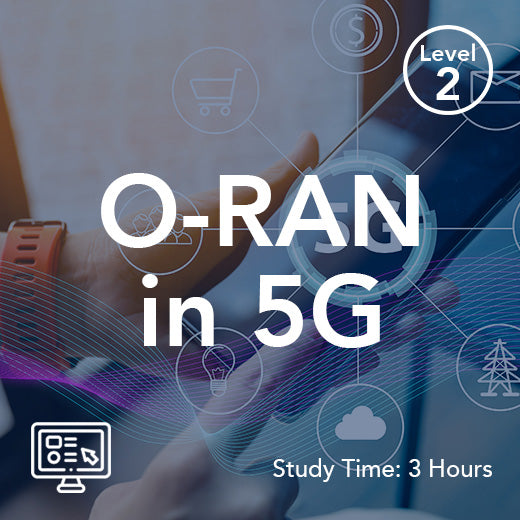
O-RAN in 5G (On-Demand)
As 5G networks become more open, intelligent, and disaggregated, understanding the Open Radio Access Network (O-RAN) is essential for professionals working in mobile network design, deployment, and optimisation. This short, single-module course provides a concise yet comprehensive introduction to O-RAN and its critical role in modern 5G networks. In just three hours, you’ll explore the key architectural and functional components that make O-RAN unique. The course begins with an overview of 3GPP architectural options and how they lay the foundation for NG-RAN deployments. You’ll then examine the principles of RAN functionality and protocols before diving into the detailed architecture of NG-RAN and O-RAN. You’ll gain a solid understanding of functional split options—crucial for enabling multi-vendor interoperability—as well as the differences between traditional and open RAN deployments. The course explains the high-level and logical architectures of O-RAN, including the roles of the Central Unit (CU), Distributed Unit (DU), and Radio Unit (RU), and how open interfaces and intelligent controllers reshape how networks are managed.Additional topics include the application of Artificial Intelligence and Machine Learning in O-RAN, the concept of the O-RAN white box, and critical considerations around fronthaul, backhaul, and interfaces like CPRI and eCPRI. Designed for technical professionals looking for a clear and accessible introduction to O-RAN, this course equips you with the essential knowledge needed to understand the future of radio access networks. Course Contents 3GPP RAN Architecture for 5G 3GPP Architectural Options RAN Functionality and Protocols NG-RAN Architecture Split Options O-RAN, O-RAN Operations and Maintenance High Level O-RAN Architecture Logical Architecture of O-RAN Artificial Intelligence and Machine Learning O-RAN White Box Backhaul CPRI and eCPRI
£95.00 £47.50
-
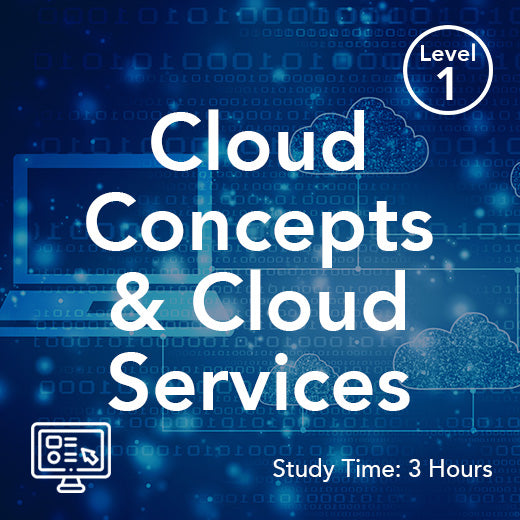
Cloud Concepts and Cloud Services (On-Demand)
Cloud computing has revolutionised how individuals, businesses, and governments access, store, and manage data. Whether you're supporting IT operations, planning digital services, or simply want to better understand this vital part of today’s technology landscape, this short, single-module course introduces the core concepts and services that define the cloud. In just three hours, you’ll start by answering the fundamental question: What is ‘The Cloud’? From there, you’ll explore the most widely used service models—SaaS (Software as a Service), PaaS (Platform as a Service), and IaaS (Infrastructure as a Service)—and how they support different user needs. The course explains how these service models compare, what they enable, and why businesses increasingly rely on them for agility, scalability, and cost-efficiency. You’ll also learn how cloud-based services are used in home and office environments and get an overview of the major cloud service providers and the roles they play in the broader ecosystem. Designed for professionals across telecoms, IT, and business functions, this course provides a practical, jargon-free entry point into the world of cloud services—perfect for anyone needing a clear understanding of cloud concepts without diving into deep technical detail. Course Contents; What is ‘The Cloud’ Types of Cloud Service Cloud Service Models and SaaS PaaS and IaaS Service Models – How Do They Compare Cloud-based Home and Office Services Cloud Service Providers
£95.00 £47.50
-

Cloud Architecture and Technologies (On-Demand)
Cloud computing underpins much of today’s digital infrastructure - but what exactly makes the cloud work? This short, single-module course demystifies the architecture and technologies behind cloud services, giving you a structured overview of how cloud systems are designed, deployed, and secured. In just three hours, you’ll explore the core cloud types - public, private, hybrid - and learn the key terminology that underpins modern cloud discussions. You’ll then look at the enabling technologies that support cloud computing, from virtualisation and containerisation to software-defined infrastructure and automation. The course goes on to explain how cloud services are architected, including layered service models, the roles of cloud orchestration and APIs, and how infrastructure is provisioned dynamically. You’ll also examine how cloud environments are managed and secured, with a focus on governance, monitoring, data protection, and access control. Ideal for technical professionals and learners seeking a deeper understanding of how cloud platforms work, this course equips you with the vocabulary, concepts, and architectural knowledge needed to confidently engage in cloud-related conversations and planning. Course Contents Cloud – Types and Terminology Cloud Technology Cloud Architecture and Services Cloud Management and Security
£95.00
-
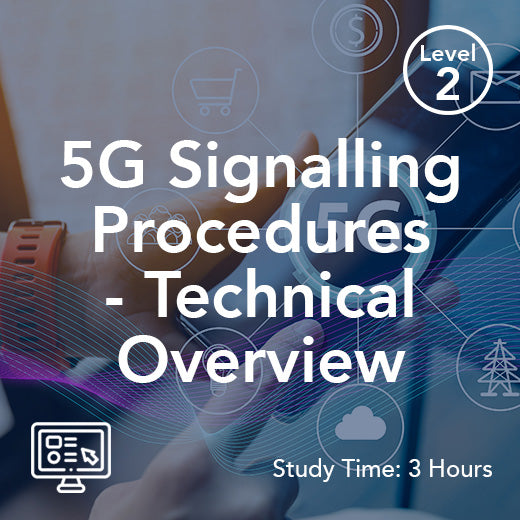
5G Signalling Procedures - Technical Overview (On-Demand)
As 5G networks mature, a solid grasp of the procedures that govern how devices and network functions interact is essential for professionals working in planning, operations, or optimisation. This short course offers a technical overview of the core signalling and operational procedures in 5G Standalone (SA) networks. In just three hours, you'll explore how 5G procedures have evolved - from initial deployments that relied on LTE signalling to fully native 5G implementations across both the core and radio access network. The course covers the step-by-step processes involved in device registration, network function discovery, and session establishment and modification. You'll also gain insight into mobility management procedures, including how 5G handles transitions between different UE states - idle, connected, and inactive - and how it manages tasks like cell selection, registration updates, service requests, and handovers. The role of the Radio Resource Control (RRC) protocol in managing radio connections, reporting measurements, and supporting dual connectivity scenarios is also explained. This course is designed to provide technical professionals with a foundational understanding of how 5G devices and networks interact through signalling and procedure flows, forming the basis for reliable service delivery in real-world deployments. Course Contents 5G Procedures NF Service Registration, Discovery, Subscription and Notification Power-on Procedures Registration Procedure PDU Session Establishment Server-triggered PDU Session Modification and QoS Flow Establishment Change of PDU Session Anchor Mobility Management and Registration Update UE Triggered Service Request Procedure RNA Update and RRC Transitions Xn-based Handover Procedure Addition of a Secondary Node Access Network Release Procedure Signalling Procedures RRC Signalling Overview NSA and SA RRC Reconfiguration Message Overview RRC Measurements Procedures MR-DC Procedures
£95.00
-

5G RAN Architecture and Features (On-Demand)
As 5G networks continue to expand and evolve, a solid understanding of the 5G Radio Access Network (RAN) is essential for those involved in mobile network planning, deployment, or operations. This short, single-module course provides a focused overview of the 5G RAN architecture and the key features that distinguish it from previous generations. In just three hours, you'll explore the structure of the 5G RAN, including the role of the gNB (Next Generation Node B) and its functional split into Centralised Units (CUs) and Distributed Units (DUs). The course explains the key interfaces - NG, Xn, F1, and E1 - that enable communication between RAN components, other base stations, and the core network. You'll also gain insight into different deployment scenarios such as Dual Connectivity (DC) and Multi-RAT Dual Connectivity (MR-DC), which allow 5G to coexist and coordinate with legacy networks. Additionally, the course covers the evolution of the fronthaul interface from CPRI to eCPRI, the importance of backhaul capacity, and the need for precise timing and synchronisation in high-performance 5G networks. Designed for technical professionals needing a clear and accessible introduction to 5G RAN architecture, this course delivers the essential concepts required to understand and engage with today’s 5G radio access technologies. Course Contents 5G RAN Overview Dual Connectivity (DC) 5G non-Standalone and Standalone Options RAN Options EN-DC NGEN-DC and NE-DC RAN User Plane Connectivity RAN Control Plane Connectivity gNB Architecture Centralized and Distributed Deployments Common Public Radio Interface (CPRI) and eCPRI Fronthaul and Backhaul Requirements Synchronisation Requirements
£95.00
-
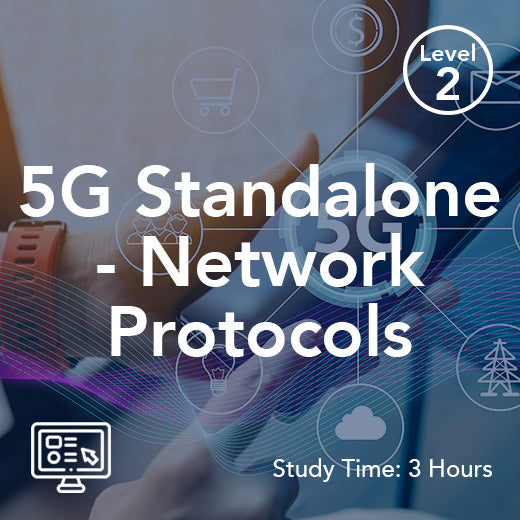
5G Standalone - Network Protocols (On-Demand)
Understanding the protocols that underpin 5G Standalone (SA) deployments is critical for anyone involved in mobile network design, deployment, or troubleshooting. This single-module course provides a practical overview of the key signalling and user plane protocols that enable communication within the 5G system. In just three hours, you'll explore how 5G SA uses modern service-based interfaces, with a focus on HTTP/2 and JSON for communication between core network functions. You'll also learn about protocol roles such as PFCP for user plane control, GTPv2-C for EPC interworking, and NAS protocols for direct signalling with the user equipment. The course also covers the essential signalling protocols in the NG-RAN, including NG-AP, Xn-AP, F1-AP, E1-AP, and RRC - critical for coordinating activity across the RAN and between the RAN and core. On the user plane, you’ll examine how data transport is managed using PDU sessions, and how session types (IP, Ethernet, Unstructured) are established and handled. You’ll also gain an understanding of QoS Flows, with parameters such as 5QI and ARP used to deliver differentiated service levels. This course is ideal for technical professionals who need a working knowledge of 5G SA protocol architecture, signalling behaviour, and data transport mechanisms - without going deep into packet-level analysis. Course Contents PDU Sessions and QoS Flows 5G QoS Parameters, ARP and 5QI Implementation of PDU Sessions IP PDU Session Types, IP Ethernet and Unstructured Multiple PDU Sessions Anchors Reflective QoS User Plane Protocol Stack Core Network Signalling Overview Hypertext Transfer Protocol (HTTP) HTTP 2 and JSON_2 Non-Access Stratum (NAS) and Access Stratum (AS) Protocols Next Generation Radio Access Network (NG-RAN) Signalling Protocols Overview RAN Protocols for the NG, FI, E1 and Xn Interfaces RAN User Plane Protocol
£95.00
-
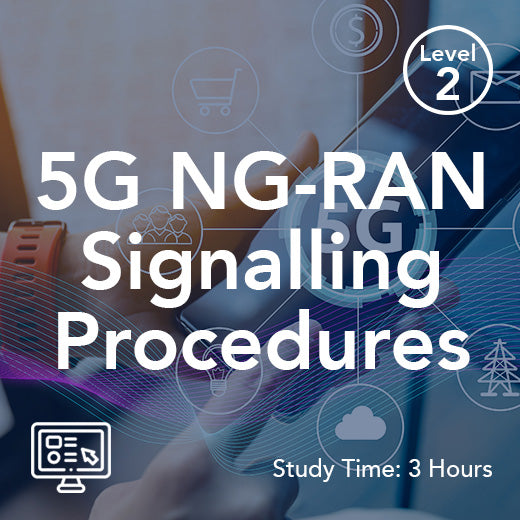
5G NG-RAN Signalling Procedures (On-Demand)
Mobility and state management are at the heart of delivering seamless connectivity in 5G networks. This short, single-module course provides a technical overview of how the 5G Next Generation Radio Access Network (NG-RAN) manages UE mobility and RRC state transitions through signalling interactions. In just three hours, you'll explore how devices move between key RRC states - RRC_IDLE, RRC_INACTIVE, and RRC_CONNECTED - and how signalling flows coordinate these transitions between the UE, gNBs, and core network functions such as the AMF, SMF, and UPF. The course covers a range of mobility procedures, including intra- and inter-gNB handovers, with a focus on signalling, context management, and data forwarding. You'll also learn how dual connectivity is managed, including the addition and release of secondary nodes. Designed for technical professionals who need a solid introduction to how 5G NG-RAN handles mobility and signalling, this course equips you with the essential knowledge required to understand and troubleshoot mobility-related behaviour in live 5G networks. Course Contents Idle Mode RRC Connected Mode RRC Inactive Mode RRC Connected Additional Handovers Secondary Nodes Final Transitions
£95.00
-

5G Standalone - Core Network Architecture (On-Demand)
As mobile networks transition to full 5G Standalone deployments, understanding the 5G Core (5GC) is essential for engineers and technical professionals involved in network design, deployment, or support. This single-module course offers a concise but comprehensive introduction to the 5G Core Network Architecture. In just three hours, you’ll explore the key building blocks of the 5G Core, including the main network functions such as the UDM, AMF, SMF, and UPF, and their roles in managing subscriber data, mobility, sessions, and user traffic. The module also explains important network and UE identifiers, tracking area concepts, and the role of service-based interfaces in enabling 5G’s flexibility. You’ll gain insight into how 5G supports roaming, interworks with legacy EPC networks, and introduces network slicing—a powerful concept that allows the same physical network to support a wide variety of use cases with different performance requirements. This course is ideal for those who need a technical overview of the 5G Core without going deep into protocol-level detail, and serves as a foundation for further learning or practical application in 5G projects. Course Contents 5G Core Network Functions Overview Reference Point Architecture 5G Roaming Architectures Service Based Architecture Service Based Interface Concepts 5G Core Network Functions Data Storage Architecture Interworking and Migration Non-3GPP Access 5G Identities Identities for Network Slicing TAC and RAN Identites
£95.00
-
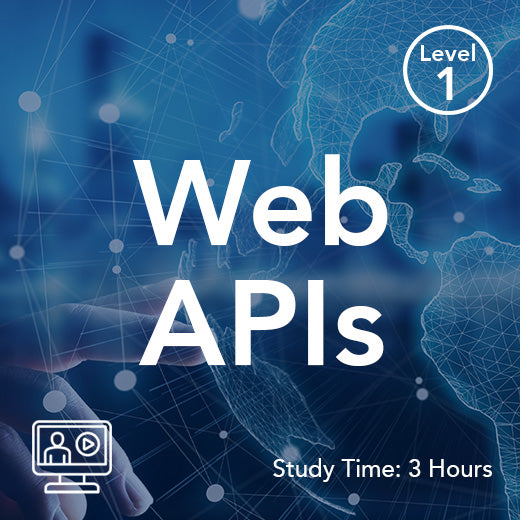
Web APIs (On-Demand)
This course provides a comprehensive and accessible overview of Web APIs - essential tools for enabling communication between modern software systems. It starts with the basics, defining what APIs are and unpacking the components of an API call, before exploring architectural styles including REST, SOAP, GraphQL, and gRPC. You’ll trace the evolution of APIs and gain insight into key protocols such as HTTP/1.1, HTTP/2, and HTTP/3, as well as common data formats like JSON, XML, and YAML. The course also covers important API standards and specifications such as OpenAPI and AsyncAPI, introduces widely used tools like Swagger and Postman, and outlines core security mechanisms including API Keys, OAuth 2.0, JWT, and OIDC. With structured reading content, visual explanations via short videos, quizzes, FAQs, and a final assessment, this course equips you with the foundational knowledge needed to understand and work with Web APIs in real-world applications. Course Contents Introduction to API Web API Core Protocols API Standards and Specifications API Tools API Security
£95.00
-
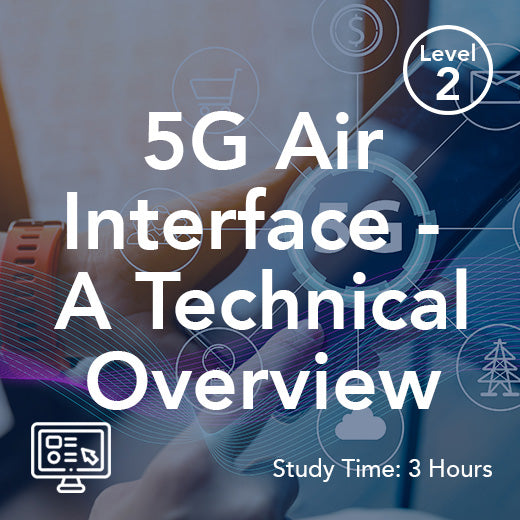
5G Air Interface - Technical Overview (On-Demand)
The 5G New Radio (NR) air interface lies at the heart of 5G’s transformative capabilities, enabling high data rates, low latency, and the flexibility to support a wide range of services - from enhanced mobile broadband to ultra-reliable low-latency communications and massive IoT. Unlike previous generations, 5G NR has been designed from the ground up without the constraint of backward compatibility, freeing it to address the diverse and demanding requirements of next-generation mobile networks. This course offers a technical deep dive into the architecture and operation of the 5G air interface. It explores how key design decisions - such as the adoption of flexible OFDMA, use of millimetre wave frequencies, large-scale antenna arrays, and adaptable subcarrier spacing - combine to deliver major improvements in spectral and energy efficiency. You'll also learn how 5G NR accommodates a wide variety of use cases through its advanced protocol stack, modulation schemes, duplexing methods, and dynamic bandwidth configurations. By the end of the course, participants will understand the principles behind 5G NR’s physical layer, its use of spectrum (including FR1 and FR2 bands), and the challenges and opportunities associated with operating at high radio frequencies. Whether you're a telecom engineer, network architect, or systems analyst, this course provides the foundational knowledge needed to work confidently with the 5G air interface. Course Contents 5G Objective and Performance Requirements Air Interface Protocol Stack Wireless Capacity Growth 5G Spectrum Overview TDD and FDD Overview Millimeter Wave and Antenna Overview mmWave Propagation Characteristics Capacity and Modulation Principles of Orthogonal Frequency Division Multiple Access (OFDMA) Inter-Symbol-Interference Bandwidth Parts Time Domain Structure PHY Resource Grid Physical Channels and Signals
£95.00
-

Inside O-RAN: Intelligent Architecture and Traffic Control (On-Demand)
5gThis short course is designed to provide a focused introduction to two key aspects of the Open Radio Access Network (O-RAN) framework: Module 1: O-RAN Architecture and Intelligent Control Explore the core components of the O-RAN architecture, including the disaggregated network functions, key interfaces, and the role of Artificial Intelligence and Machine Learning in enabling intelligent, automated network optimisation. Module 2: O-RAN Use Cases and Traffic Steering Learn how O-RAN supports more flexible and mobile-centric traffic steering strategies. The module explains the motivations behind operator-defined policies, the roles of the RICs, and includes a practical use case illustrating how traffic can be dynamically steered based on service requirements.
£95.00
-

TowerCo Master Service Agreements (MSA) (On-Demand)
A concise course on interpreting TowerCo Master Services Agreements, focusing on telecommunications industry contracts. While this course is not a substitute for legal advice, it will empower you to understand and navigate these complex agreements, covering topics from the importance of contracts to verifying agreement accuracy, contract validity, proactive contract management, and an in-depth exploration of typical contract sections. By the end of this course, you'll be equipped to make informed decisions and safeguard your organisation's interests. Course Contents: Contractual fundamentals Jargon buster approach Cellsite outsourcing in context Importance of proactive contract management to avoid costly disputes Generic form of a TowerCo Master Services Agreement Authority Matrixes
£250.00
-
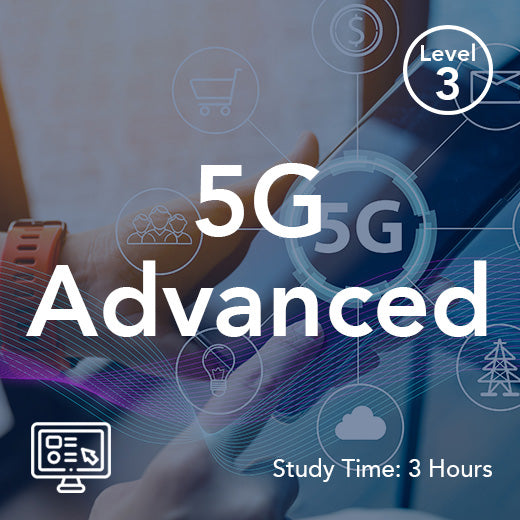
5G Advanced (On-Demand)
5G Advanced On-Demand is a comprehensive course designed to explore the latest advancements in 5G technology, specifically focusing on the enhancements introduced in 3GPP Release 18. This course delves into how 5G Advanced significantly boosts network capabilities, paving the way for future demands and innovations in the telecommunications industry. By understanding the specific features and improvements that 5G Advanced brings to the table, telecom professionals, network engineers, product managers, and individuals involved in strategic planning or technical implementation can stay ahead of the curve and leverage these advancements to drive success in their respective industries. With a concise overview of the enhancements introduced by 5G Advanced, participants will gain valuable insights into how these improvements can revolutionize their current practices and infrastructure. From base capability improvements to specific features unique to 5G Advanced, this course covers a wide range of topics essential for professionals looking to stay informed and competitive in the rapidly evolving telecommunications landscape. Whether you are looking to enhance your technical knowledge or gain a strategic edge in your industry, 5G Advanced On-Demand offers the knowledge and expertise needed to thrive in the era of advanced connectivity and communication technologies. Who Would Benefit This course is ideal for telecom professionals, network engineers, product managers, and anyone involved in strategic planning or technical implementation within telecommunications and related industries who require a concise overview of the improvements 5G Advanced introduces, along with an examination of the specific features and how they enhance their respective industries. Course Contents Introduction 5G Advanced – Base Capability Improvements Specific 5G Advanced Features
£95.00
-

Artificial Intelligence (AI) Fundamentals for Telecoms (On-Demand)
The Artificial Intelligence Fundamentals course is designed to provide participants with a comprehensive introduction to the field of artificial intelligence (AI). Through a combination of theoretical concepts and practical applications, participants will gain a solid foundation in AI and its various subfields, including machine learning, natural language processing, computer vision, and robotics. We explore the use of AI in industry, and in particular in Telecoms and related sectors. By the end of the course, participants will have a strong grasp of AI concepts, techniques, and their real-world applications – particularly in telecoms. They will be equipped to pursue further studies in AI or apply their knowledge to diverse domains where AI plays a significant role. Prerequisites There are no specific prerequisites for this course. However, a basic understanding of programming concepts would be beneficial. Course Contents Introduction to Artificial Intelligence Machine Learning Natural Language Processing (NLP) Computer Vision Robotics and Autonomous Systems AI in Industry Ethics and Responsible AI
£95.00
-
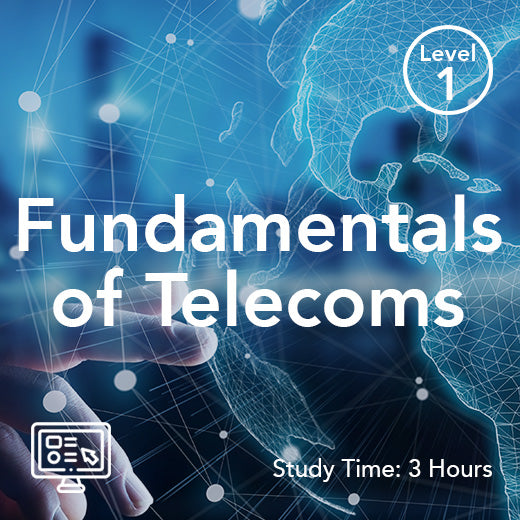
Fundamentals of Telecommunications (On-Demand)
This course will cover a wide range of topics, starting with the basics of services and connectivity. It will provide insight into the evolution of telecommunication networks over time, reflecting on both historical advancements and future trends. We will begin with an introduction to the foundational aspects of telecom services and connectivity, setting the stage for more detailed explorations. We will then delve into fixed access technologies, starting with traditional copper pair connectivity and progressing through the evolutionary phases of fixed broadband access. This will include a thorough discussion of the technologies that have shaped and continue to influence fixed network landscapes. The mobile sector will receive a focused analysis beginning with the fundamental cellular concepts. We will explore the evolution of mobile broadband, especially under the frameworks established by the 3rd Generation Partnership Project (3GPP), covering technologies from GSM to advanced LTE and 5G networks. An essential component of this course will be a deep dive into operational support systems (OSS) and business support systems (BSS), which are critical for managing modern telecommunications services. We will examine the key platforms that support telecom services, such as billing, customer service, and network management systems. The course will also cover the burgeoning area of the Internet of Things (IoT), detailing how this technology integrates into existing telecom infrastructures and the new opportunities it creates. Additionally, we will consider the infrastructure backbone of the telecom industry, focusing on data centres and the relative costs associated with telecom infrastructure, excluding spectrum costs. Course Contents: Introduction Services and Connectivity - Evolution Fixed Access Mobile Access Support Systems Infrastructure
£95.00
-

5G – Standalone, Enablers for the Industry & Business Perspective (On-Demand)
With SA 5G, we witness the evolution of mobile networks, from being reliant on legacy infrastructure, to achieving true independence - and unlocking unprecedented capabilities that enables 5G to support a much wider range of industrial use cases. In this course, we guide you through the benefits and challenges of deploying Standalone 5G, exploring its architectural advancements, unique features, and the benefits it brings to both consumers and businesses. We then highlight the enhanced capabilities and expanded use cases made possible by key technology enablers - including network slicing, edge computing, virtualization, non-terrestrial networks (NTNs), network exposure, and network automation. We discuss the impact of 5G SA for network operators, service providers, and enterprises - exploring the opportunities and challenges that arise in the deployment and management of advanced 5G networks. Who Would Benefit Ideal for anyone needing clarity on 5G trajectory – including capabilities & use cases Prerequisites A basic appreciation of the telecoms landscape – both technical and business Course Contents 5G Base Capabilities A Business Perspective 5G Standalone (SA) 5G Enablers for Industry
£95.00
-

Wray Castle Hub (12 Month Subscription)
Annual Telecoms Training Subscription Package with Unlimited access to 500+ hours of key training material Empower your professional development by building your knowledge of key technology and business topics within the telecoms industry. Unlimited access to future new courses that will cover the latest technology developments as they are added to Hub throughout your 12-month subscription period. Endlessly flexible and applicable to any role within the telecoms industry a subscription to Wray Castle Hub is your ultimate learning resource. You can choose to follow one of our suggested learning pathways, build your own or dip into the learning material module by module. The Wray Castle Hub is also available as an 6-Month Subscription for £945. Learn more here.
£1,400.00
-
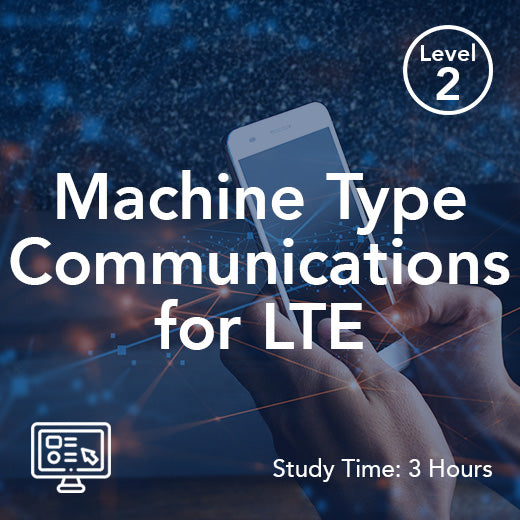
Machine Type Communications for LTE (On-Demand)
Mobile communication systems were originally designed to support voice (with SMS), but then focused primarily on developing data connectivity. With broadband connectivity representing the major areas of opportunity, networks were standardised, deployed and optimised to fully support that [fairly narrow] set of use cases. More recently, machine to machine communication, the Internet of Things (IoT) and connected innovation have seen massive growth, and become a much bigger part of the communications industry. However, the data connectivity requirements are very different to that of broadband. In order to optimally support this type of data, a number of modifications, new features, and complimentary technologies have been introduced to the networks. In LTE, these are grouped under the term Machine Type Communications (MTC). This course explores the technical aspects of MTC for LTE, and includes an examination of NB-IoT (Narrowband IoT) as a complimentary technology. Initially, the course provides an overview of IoT and low power networking / connectivity systems, and highlights the role and requirements of LTE for MTC. We then look at the features and performance of the different categories of MTC UE (User Equipment), the Air Interface modifications and features, and the Cellular IoT (C-IoT) enhancements to the Evolved Packet Core (EPC). Course Modules Introduction to LTE and the Internet of Things (IoT) LTE Technologies for the IoT NB-IoT and IoT Core Network Enhancements
£95.00
-
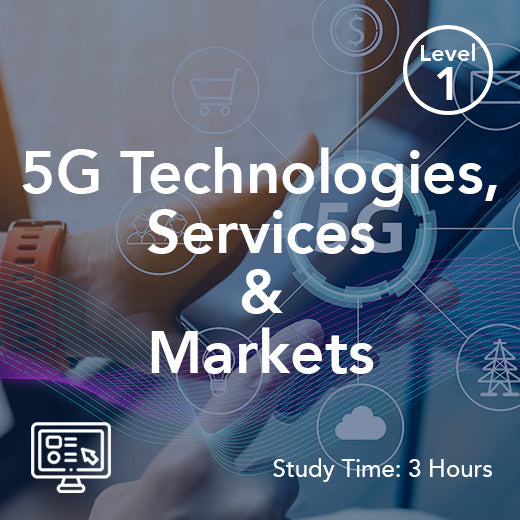
5G Technologies, Services and Markets (On-Demand)
This 5G Technologies, Services and Markets on-demand course is a non-technical introduction to the 5G mobile communication system, including its capabilities, general structure and operation, as well as its position as a development of previous technologies. The course also covers the place that 5G holds in the telecommunications market, and how that is developing. This 1-day training course is designed to provide a comprehensive overview of 5G technologies, services, and markets. The course covers the basics of 5G mobile communication systems, including their capabilities, structure, and operation, as well as their evolution from previous technologies. Participants will also gain insights into the current landscape of the telecommunications market and the role that 5G plays in shaping its future. Ideal for non-technical professionals in the mobile or fixed telecommunications sector, this course requires no prior technical knowledge but some familiarity with the industry would be beneficial. Topics covered include an introduction to 5G, market drivers, use cases, performance objectives, key features, network architectures, voice services, industry players, standardization, and the relationship between 5G, LTE, and Wi-Fi. By enrolling in this course, participants will gain a solid understanding of 5G technologies and their impact on the telecommunications industry. Stay ahead of the curve and enhance your knowledge with this engaging and informative training opportunity. This self-paced on-demand distance learning course features illustrated course books, videos, tests and full tutor support. Who would benefit This course is intended for non-technical professionals either new to, or already working in, the mobile or fixed telecommunications sector. Prerequisites No technical knowledge is assumed but some familiarity with the telecommunications industry would be beneficial. Topic Areas Include Introduction to 5G Market drivers for 5G Use cases for 5G Performance objectives and spectrum requirements Concepts and key features of 5G Architecture of the core and radio access networks of 5G Voice services in 5G Key industry and market players Standardisation and timelines for 3GPP and the ITU 5G, LTE and Wi-Fi – a holistic approach
£95.00
-
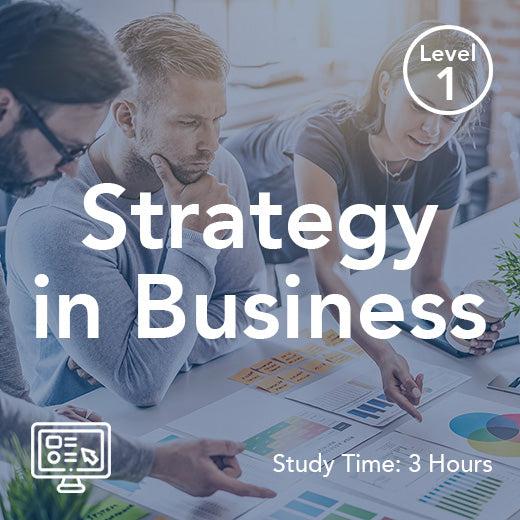
Strategy in Business (On-Demand)
Strategic decision-making is a key component of the vast majority of successful businesses, and the impact of those decisions is very likely to have a huge bearing on the success (or otherwise) of the organisation. Despite the intention that company strategy should drive and guide the mix of activities, and both focus and align efforts within appropriately configured units / departments, very few companies give it the time and attention needed to maximise the impact of good decision-making. This programme looks at each component of strategy in turn, with the decision-making process at the heart of a much more extensive set of activities need to maximise the impact of good strategy. We look at the nature of Strategy; building Awareness (industry, market, business dynamics, company-specific); strategic Analysis; strategy Development; strategy Execution; and key Performance Enablers. We draw all the relevant and varied information together, presenting it as a single flow of processes that can be used to drive successful strategy within any business, department or organisation. Who Would Benefit? These programmes deliver comprehensive training for employees at all levels within the organisation. They would benefit employees, mid-senior managers, directors, specialists, consultants and identified talent. Topics Covered: Understanding Strategy, Industry and Business Dynamics Understanding the Nature of Strategy Building Awareness Analysing the Market; Developing Strategy & Competitive Advantage, Strategy Execution, KPIS & OKRs Carrying Out Strategic Analysis Developing the Strategy Strategy Execution Key Performance Enablers
£95.00
-

Optimising Operations & Transformation (On-Demand)
Organisations tend to have a great deal of momentum – the bigger the organisation, the more difficult it can be to change, pivot and reposition. Even smaller business units can be very difficult to transform. Most successful businesses are in a constant state of flux, and they embrace change in order to optimise and pivot accordingly. Whether it is slow evolution, or larger initiatives that require fundamental reorganisation and refocusing of resources and people, the best businesses are able to drive those changes, embrace the new opportunities and maintain their agility and flexibility. This programme explores change within businesses / organisations – whether it is a case of optimising operations, or full-on transformation, we hit the key barriers and enablers for change, before exploring the change process and the role of the leader and key stakeholders. People issues are given a particular focus – in terms of individual and team factors, and the critical role that culture plays in the change process (and in the ongoing organisation). Exercises, case-studies, discussions and break-outs are used to reinforce learning, and to build confidence that participants need to effect positive change in the workplace – whatever size of organisation they work in. Topic Covered Include Key Principles – Optimising Operations and Transformation The Issue of Company Momentum Momentum – the Impact of Corporate Culture and DNA Momentum – Impact of Corporate Attitude to Risk Momentum and Risk – the Results Resistance to Change – Illustrated Understanding the Nature of Change Change – a Non-Stop Journey Evolving to Stay Relevant and Optimised
£95.00
-

Leadership in Business (On-Demand)
Being an effective leader is difficult. Some in leadership positions struggle with the basics, others have huge gaps in their understanding, and many restrict themselves to management activities - actively avoiding actual leadership wherever possible. In most cases, the confidence to lead effectively is in short supply, and those that do have the confidence often confuse dominance, or power, with leadership. However, organisations who see good leadership and culture as THE key enablers for their people, are the ones most likely to thrive and prosper – in whatever field they are operating in. This comprehensive programme builds a solid understanding of leadership and culture in business, giving current and aspiring leaders the confidence and tools needed to better engage, guide, develop, coach, organise, assess, and most critically, empower their people, teams and departments. We develop a deep understanding of leadership, including all key aspects related to ourselves as an effective leader; understanding and engaging with our people; developing successful teams; and influence as a primary foundation. We follow this by an extensive look at how we can successfully support and deploy our people whilst building a balanced culture that maximises success, enables innovation, and drives engagement at every level. Exercises, discussions, break-outs, case studies and examples are used throughout in order to maximise learning, build confidence, and establish the foundations for successful leadership. Topics Covered Include Leadership in Business / Organisations Developing Effective Teams Influence and Communication Supporting and Deploying Effective People – Culture and Innovation
£95.00
-

Developing and Communicating Compelling Customer Propositions (On-Demand)
For businesses to be successful, they need to align with their customers’ requirements in a number of key ways - but fundamentally it comes down to understanding the customer(s), creating compelling customer propositions, communicating those propositions, and enabling the value exchange. It encompasses product development, marketing and marketing communications, and business development / sales activities. This programme looks at the customer proposition holistically. It covers all the key elements needed to develop a sustainable business model that is tightly aligned with customer requirements, gets the right information in front of the right customers in an engaging and compelling way, and supports the overall strategy by delivering sustainable competitive advantage. We use exercises, case studies, break-outs and discussions to develop competencies and confidence, and the tools used will allow participants to apply the techniques to the workplace immediately. Topic Areas Include: Creating Compelling Customer Propositions Customers – Making Critical Choices Strategy and the Customer Proposition Customer Segments Products Brand Components of a Brand Pricing Expectation and Consistency The 80/20 Golden Rule Sales and Business Development Linking Marketing and sales – Lead Generation Sales – Common Objections Overcoming Common Objections Establishing a Sales Decision Process Responding to RFPs Telecoms Business Simulation Communicating Compelling Customer Propositions Channels to Market Key Elements of the Marketing Message The Psychology of Persuasion Segments, Profiles, Emotion Marketing Communications Online Marketing Marketing Systems and Frameworks Customer Retention and Loyalty Marketing Communications Plan Developing a Marketing Communications Plan Developing a Campaign for Lead Generation / Sales Assessing the Marketing and Communications Plan - KPIs International Marketing Market Research Marketing Resource
£95.00
-

Maintaining Effective Governance (On-Demand)
Course Code LB06 Course Summary The business world is ever-changing, with focus shifting constantly as industries develop and evolve. Increasing requirement for good governance, however, has been a constant focus over a number of decades now. Companies that embrace good governance as part of their core value-system are invariably in a much better position as they scale, or as they expand /evolve their operating footprint to embrace new sectors or geographies. At its most effective, good governance, is felt throughout the organisation – with shareholders, employees and customers all more likely to engage in a positive and engaging way as the organisation develops. At its worst, bad governance directly contributes to dangerous working conditions or environmental disaster – and very likely, costly lawsuits, and competitive disadvantage. This short module is designed to complement our other business programmes by exploring key aspects of governance and what it all means for businesses. Comprehensive discussions and examples are used to illustrate the wide and varied topics covered, the critical focus areas within each topic, and how progressive governance can be used to positively impact, not only the business, but wider society. Prerequisites None Topics Covered include: Health and Safety Data Protection Ethical Financial Reporting Employment Practices Charity / Social Engagement Environment and Sustainability Aligning with the UN Sustainable Development Goals Consequential Thinking – The Four-Way Test Sustainability – Example Approached On-Demand Online Training Our self-paced on-demand distance learning programmes are accessible on any computer, tablet or smartphone and allow you to study at a time and location that is convenient to you. Each course includes: Illustrated Course Books - featuring leading edge knowledge from subject matter experts. Videos - Detailed videos expand the points covered in the course books, discussing topics in greater depth. Tutor Support – Dedicated course tutors are available to answer any questions you might have throughout your studies. Formative Assessment - Modules include regular quizzes to support learning by testing your knowledge of the subject matter. Certification– Successfully complete the end of module tests to earn Digital Badges to demonstrate the depth of your knowledge of the topic.
£95.00
-
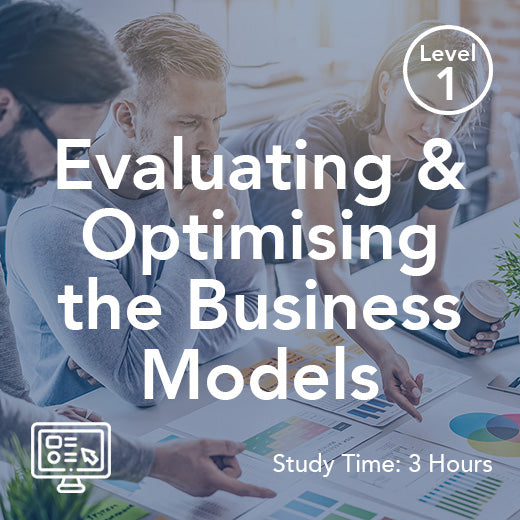
Evaluating and Optimising the Business Models (On-Demand)
Business models define a mix of activities required within a business to support a specific strategy. Collectively, one or more business models, aligned to a well-thought-out strategy, will deliver the competitive advantage needed to compete successfully in the market, and against any relevant competition. Business models are often complex, with multiple models running in parallel, and often in competition with each other within the business (in addition to the external competition). In this programme, we deconstruct the business model in order to fully understand its component parts before looking at how those parts can be optimally configured / reconfigured in order to maximise value creation and competitive advantage. We use examples, exercises and case studies to build a solid foundation that can be used within your own organisation to help drive success. Who Would Benefit? These programmes deliver comprehensive training for employees at all levels within the organisation. They would benefit employees, mid-senior managers, directors, specialists, consultants and identified talent. Topic Areas Include: Definitions and Components of a Business Model Business Model(s) – In the Bigger Picture Relationship - Strategy, Business Models and Operations Business Model Definition Understanding Value Extraction Developing The “Fit” of Activities – Examples Partnerships and the Business Model Customer Segments and Value Propositions Business Models – Options, Assessment and Development Understanding Value Business Model Disruption Business Model Adaptation Defining New Business Models Successful Examples for Redefined Business Models Business Models – The [Many] Options Explored
£95.00
-

Business Finance – For Non-Financial Managers (On-Demand)
All successful employees, managers and leaders who want to maximise their contribution within the business or organisation need a solid grasp of finances. Whether they are talking strategy, budgets, or customer propositions, it is inevitably the finances that drive the decisions and determine how performance is measured. Being financially literate gives the individual a fundamental business tool, as well as the credibility, to help drive success and to maximise value creation. KPIs can be properly evaluated, major decisions can be grounded in financial reality, and both forecasting and reporting can be used more reliably to help guide efforts and provide the required focus for departments and teams. A key aspect often overlooked, is that greater confidence in both the financial position, and the control mechanisms that are available to employees and managers, will enhance a leader’s risk-awareness. In turn (depending on a range of other factors), this can be a key enabler for business culture that embraces greater levels of creativity and value creation. This programme provides a comprehensive foundation in business finance – covering all the major areas needed to be a fully-functioning member of the mid-senior management team. It is ideal for current or aspiring managers, specialists with financial responsibility, or identified talent / graduates. Although financial principles do not change, they can be applied in very specific ways, depending on the industry / organisation. Examples, case studies and exercises are tailored accordingly Topic Areas Include: The Financial Cycle and Reporting Key Accounting Concepts The Company Operating (Finance) Cycle Three Principal Accounting Documents KPIs, Ratios and Financial Analysis Understanding Finance Key Financial Ratios – Categories and Examples Profitability Efficiency Equity, Loans, and Gearing / Leverage Valuation - Controlling Investment Financial Control, Budgets and Evaluating Initiatives / Projects The Importance of Budgeting and Forecasting Budgets – Getting Specific Mitigating Bad Budget Culture (Teams Aiming for 100% Budget Spend) Understanding Return on Investment (ROI) Cumulative Cash Flows Calculating ROI and using Net Present Value (NPV) Assessing Projects and Using NP
£95.00
-
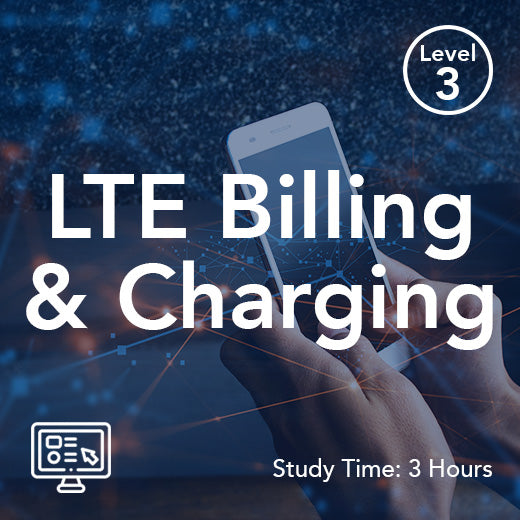
LTE Billing and Charging (On-Demand)
Our LTE Billing and Charging Training Course provides a comprehensive technical overview of the billing and charging architecture specifically designed for 4G LTE networks. Participants will gain insights into LTE bearer, traffic flow, and Quality of Service (QoS) concepts, as well as an in-depth understanding of the architecture of both online and offline billing systems. Key nodes, interfaces, and protocols used for transporting billing and charging information will be explored, along with the interactions with the billing system during basic LTE procedures. This course is ideal for engineers, designers, managers, and individuals involved in the development, deployment, or operation of LTE billing and charging systems. Familiarity with the LTE Evolved Packet Core is assumed, and experience with 2G or 3G billing systems would be beneficial. Topics covered include EPS bearer concepts, LTE QoS models, packet flows, deep packet inspection, policy and charging control, flow-based charging, billing architecture, charging data capture points, protocols (Diameter, CAP), interfaces (Gy, Gz, Rf, Ro), charging criteria, CDR formats, CDR generation, and charging interaction with basic LTE procedures. Join us for this informative and practical training session to enhance your knowledge and skills in LTE billing and charging. This self-paced on-demand distance learning course features illustrated course books, videos, tests and full tutor support. Who would benefit Engineers, designers, managers and others involved in the development, deployment or operation of LTE billing and charging systems. Prerequisites Familiarity with the LTE Evolved Packet Core is assumed. Experience of 2G or 3G billing systems would be beneficial. Topic Areas Include Review of EPS bearer concepts and LTE QoS models Packet flows, service data flows and traffic flow aggregates Deep packet inspection – heuristic algorithms and bearer-aware applications Outline of policy and charging control LTE billing and charging concepts Flow-based charging Billing architecture Online and offline charging systems Charging data capture points (S-GW, PDN-GW) IMS charging capture points Charging Data Function (CDF) Protocols – Diameter, CAP Interfaces – Gy, Gz, Rf, Ro and others Charging criteria – time-based, volume-based, application-based CDR formats CDR generation Charging interaction with basic LTE procedures
£95.00
-
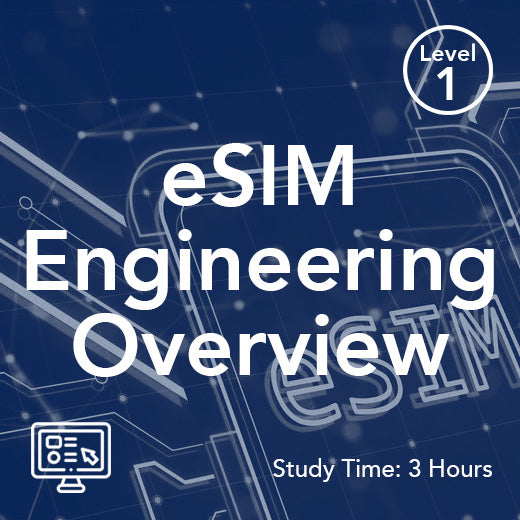
eSIM Engineering Overview (On-Demand)
Our eSIM Engineering Overview Training Course provides a comprehensive technical overview of eSIM technology and the latest remote SIM provisioning specifications from GSMA. This course delves into the role of the SIM, the transition from physical to digital, system architectures for both M2M and Consumer applications, the evolution of eSIM, and a glimpse into the future of this technology. Engineers, product managers, and other professionals seeking to implement eSIM-based products and services will benefit greatly from this course. Participants are expected to have a general engineering background with some knowledge of GSM SIM technology. While not mandatory, a basic understanding of mobile networks would be advantageous. The course covers essential topics such as Introduction to eSIM, GSMA Consumer eSIM Specification, GSMA M2M eSIM Specification, GSMA Consumer eSIM Specification Enhancements, and The Future of eSIM. This self-paced on-demand distance learning course features illustrated course books, videos, tests and full tutor support. Who would benefit The course is intended for engineers, product managers and other staff who are looking to prepare for or actively roll out eSIM-based products and services within their organisations. Prerequisites A general engineering background with some knowledge of GSM SIM technology is assumed. A basic understanding of mobile networks would be desirable. Topic Areas Include Introduction to eSIM GSMA Consumer eSIM Specification GSMA M2M eSIM Specification GSMA Consumer eSIM Specification Enhancements The Future of eSIM
£95.00























































